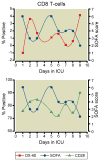Advances in the management of sepsis and the understanding of key immunologic defects
- PMID: 21952252
- PMCID: PMC3433833
- DOI: 10.1097/ALN.0b013e31823422e8
Advances in the management of sepsis and the understanding of key immunologic defects
Abstract
Anesthesiologists are increasingly confronting the difficult problem of caring for patients with sepsis in the operating room and in the intensive care unit. Sepsis occurs in more than 750,000 patients in the United States annually and is responsible for more than 210,000 deaths. Approximately 40% of all intensive care unit patients have sepsis on admission to the intensive care unit or experience sepsis during their stay in the intensive care unit. There have been significant advances in the understanding of the pathophysiology of the disorder and its treatment. Although deaths attributable to sepsis remain stubbornly high, new treatment algorithms have led to a reduction in overall mortality. Thus, it is important for anesthesiologists and critical care practitioners to be aware of these new therapeutic regimens. The goal of this review is to include practical points on important advances in the treatment of sepsis and provide a vision of future immunotherapeutic approaches.
Figures




References
-
- Levy MM, Fink MP, Marshall JC, Abraham E, Angus D, Cook D, Cohen J, Opal SM, Vincent JL, Ramsay G. 2001 SCCM/ESICM/ACCP/ATS/SIS International Sepsis Definitions Conference. Crit Care Med. 2003;31:1250–6. - PubMed
-
- O’Brien JM, Jr, Ali NA, Aberegg SK, Abraham E. Sepsis. Am J Med. 2007;120:1012–22. - PubMed
-
- Vincent JL, Rello J, Marshall J, Silva E, Anzueto A, Martin CD, Moreno R, Lipman J, Gomersall C, Sakr Y, Reinhart K. International study of the prevalence and outcomes of infection in intensive care units. JAMA. 2009;302:2323–9. - PubMed
-
- Vincent JL, Sakr Y, Sprung CL, Ranieri VM, Reinhart K, Gerlach H, Moreno R, Carlet J, Le Gall JR, Payen D. Sepsis in European intensive care units: Results of the SOAP study. Crit Care Med. 2006;34:344–53. - PubMed
Publication types
MeSH terms
Substances
Grants and funding
LinkOut - more resources
Full Text Sources
Other Literature Sources
Medical

